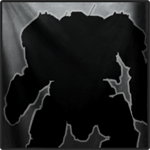 Yeach, on 02 April 2012 - 08:23 PM, said:
Yeach, on 02 April 2012 - 08:23 PM, said:
It doesn't seem that the right or left torso have "bone" structure as they are not indicated in the criticals.
If the internal structure was just the skeleton, then it would be much harder to hit (if you assume that the skeleton "bones" are small); yet once you strip off the armor of a mech, you are hitting into the internal structure.
Is it to believe that a mech with very few criticals (in the torsos) to be hollow inside?
The internal structure is the skeleton & joints of the mech that everything else mounts to, just like the chassis of a truck. The internal structure itself is not represented in the critical slots, it is represented on the Internal Structure Diagram of the record sheet. The criticals are the parts that are bolted on top of the internal structure, such as the reactor that supplies the power and the actuators that make the joints move (note that destroying a shoulder actuator doesn't make the arm fall off, it just locks up the shoulder joint - to make the arm fall off you have to destroy the skeleton, or IS). The armor is then wrapped around all of those pieces (internal structure and critical slots).
The sections of a mech with few things in them aren't hollow shells, if they were every mech would look exactly the same. Each section of a mech is built large enough to hold the parts contained within it, and no bigger. That's why a critical hit always hits something, because there are no "empty" critical spots inside a mech. The mech is exactly big enough to hold what it needs to hold and no bigger. A mech's left torso can contain up to 12 critical locations, but if there isn't anything in those locations it just means that part of the mech is physically smaller, not that it is a hollow shell of empty space. Additionally, there are many things that the Battletech damage system just ignores, like coolant plumbing, wiring, ammo feed mechanisms & ammo bay reloading doors, etc. These can all be assumed to take up space as well, we just don't track them for simplicity's sake.
Take a Hunchback for example. That big AC/20 in the right torso means that the right torso is physically much larger than the left torso. The Hunchback's left torso isn't built to the same size and filled with empty space without purpose, it is just physically smaller because there are less things to put in there (just a couple of ammo bins). To make the tabletop game balanced and easy to play the rules had to assume all mechs had basically the same structure & proportions, because having a separate hit table for every single mech would be impractical, but in a more realistic sense some locations are larger than others, inside and out. The right and left torsos of a Locust are tiny compared to the ones on the Hunchback because the Locust doesn't have anything in them - there just isn't any way to model this in a practical way for a tabletop system.
When you roll a miss in the tabletop game, you can imagine all sorts of things happened... maybe your missiles hit the target but failed to arm properly, or maybe that autocannon shell glanced off a highly angled armor plate. Maybe you hit a location where all the armor is gone and the laser beam went between two pieces of internal structure and passed straight through the mech without hitting anything, just by dumb luck. Or maybe your aim just sucked. A miss can be a miss for a dozen reasons - the dice are just there to tell you what happened. How it happened is up to you and your imagination.
There are certainly much more realistic ways to model battle damage than the ones used in the tabletop rules, especially in a 3D game where you can actually track where hits are made instead of having to rely on RNG and imagination. They just wouldn't be practical or fun to do in a tabletop scenario. Try not to get too bogged down in the minutiae.
-E
 Yeach, on 02 April 2012 - 08:23 PM, said:
Yeach, on 02 April 2012 - 08:23 PM, said:

























